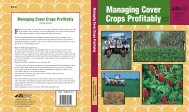Validation and Marker Assisted Selection of Three QTL Conditioning ...
Validation and Marker Assisted Selection of Three QTL Conditioning ...
Validation and Marker Assisted Selection of Three QTL Conditioning ...
Create successful ePaper yourself
Turn your PDF publications into a flip-book with our unique Google optimized e-Paper software.
<strong>Validation</strong> <strong>and</strong> <strong>Marker</strong> <strong>Assisted</strong><strong>Selection</strong> <strong>of</strong> <strong>Three</strong> <strong>QTL</strong><strong>Conditioning</strong> Fusarium HeadBlight Resistance in WheatJianli Chen, Carl. Griffey, , Jody Fanelli, , <strong>and</strong> Saghai Maro<strong>of</strong>Virginia Polytechnic Institute & State University
Outline• Introduction• Materials & Methods• Results• Discussions
Constraints that Greatly Limit theDevelopment <strong>of</strong> Resistant Varieties• Poorly adapted <strong>and</strong> partially resistantgermplasm• Multiple components <strong>of</strong> resistance• Laborious <strong>and</strong> lack <strong>of</strong> cost effectiveselection system• Confounding environmental effects
Breeding Constrains: resistancecomplexity• Type I: Resistance to initial infection• Type II: Resistance to spread <strong>of</strong>infection within a spike• Type III: decomposition or non-accumulation <strong>of</strong> mycotoxin• Schroeder & Christensen, 1963; Wang& Miller, 1988; Mesterhazy, , 1995)
Disease Screening is Laborious <strong>and</strong> Costly UsingConventional Methods
MAS for FHB Resistance• MAS may be an alternative selection system for FHBresistance.• Extensive efforts have been made previously to map <strong>QTL</strong> fortype II resistance; but little is known about the significance<strong>and</strong> genetic control <strong>of</strong> other types <strong>of</strong> resistance.• Over 18 chromosome regions have been reported; but fewhave been validated.• Two <strong>QTL</strong> on 3BS <strong>and</strong> 5AS have large effect <strong>and</strong> are stable inseveral known resistance sources.• One <strong>QTL</strong> on 3AS has a large effect in durum wheat (Chen etal., 2006), <strong>and</strong> in Frontana ( Steiner et al., 2004) <strong>and</strong> inF201wheat (Shen(et al., 2003).• Little is known about the effectiveness <strong>of</strong> MAS <strong>of</strong> the three<strong>QTL</strong> in adapted backgrounds.
Objectives <strong>of</strong> Current Study• Validate <strong>and</strong> characterize the three <strong>QTL</strong>s fortype I, type II, <strong>and</strong> type III resistance• Elucidate the potential use <strong>of</strong> MAS for thethree <strong>QTL</strong> in adapted backgrounds
Materials & Methods• Experiment I• 96 Doubled haploid lines derived froma cross between W14 <strong>and</strong> Pioneer2684• Two GH tests (2001 & 02) – floretinoculation• One field test (2004) – sprayinginoculation
Materials & Methods• Experiment II• Sixty SRW wheat lines• These lines were developed by acombination <strong>of</strong> top-crossing, backcrossing,<strong>and</strong> doubled haploid breeding methods• Two GH tests (severity) <strong>and</strong> two field tests(incidence, severity, <strong>and</strong> DON)
Floret Inoculation - Greenhouse
FHB Severity (%) – Type II resistanceAt 21 st day after inoculation
Measurement <strong>of</strong> DON contentShimadzu QP2010 GC/MS system
Spray-Inoculation: Field
FHB Incidence (%) – Type I resistanceFHB Severity (%) – Type I & II resistance
DON Content – Type III resistance
Data Analysis• Linkage analysis - Mapmaker 3.0a, L<strong>and</strong>er et al.,1987• <strong>QTL</strong> analysis – <strong>QTL</strong> Cartographer, Wang et al.,2004• Composite interval mapping (CIM)• A <strong>QTL</strong> was declared significant when LOD > 2.2• LOD (logarithm <strong>of</strong> odds) threshold wasdetermined by permutation• Regression Analysis (SPSS, p < 0.05)• Homogeneous analysis-Duncan test
Results & Discussions• <strong>Validation</strong> <strong>of</strong> the three <strong>QTL</strong> in thefirst population• Genetic characterization <strong>of</strong> the three<strong>QTL</strong> in the two populations• Strategy for MAS <strong>of</strong> the three <strong>QTL</strong>
<strong>Marker</strong> <strong>Validation</strong> – 23 SSR + 2 STS3BSgwm389barc075gwm533barc133STS3B142STS3B66gwm493cfd079Liu et al., 2006;Chen et al., 20065ASbarc001barc117barc056barc186barc040barc100gwm156barc186barc197Hermann et al.,2004; Chen et al.,20063ASbarc045gwm002gwm032gwm674barc019barc067wmc428wmc264Shen et al., 2003;Somers, et al., 2005;Chen et al., 2006
Fig.1. Genetic Maps <strong>of</strong> W14
Fig. 2. Likelihood map for type I, II <strong>and</strong> IIIresistance <strong>QTL</strong>
Table 3. Putative <strong>QTL</strong> for type I, II, <strong>and</strong> III<strong>QTL</strong>-markersType IType IIType III<strong>QTL</strong>ClosestmarkerLODR 2LODR 2LODR 23BSXgwm533A7.10.283BSXbarc1332.50.097.30.266.30.243BSXSTS1421.70.067.80.286.40.245ASXbarc1177.70.292.60.09
Table 4. Homogeneous analysis among fourhaplotypes <strong>of</strong> two <strong>QTL</strong> for type I, II, <strong>and</strong> IIIresistance in DH population.3BSHaplotypes5ASNo. <strong>of</strong>Greenhouse,2001&02Mean DataField, 2004M1,M2M1LinesIIIIIII & II1++2414.5a2.8a43.9a10.9a2+-2217.1a3.9a65.9bc15.3bc34--+-151524.8b41.3c15.2a56.3c53.7ab78.2c14.2ab20.1cA to c represents homogeneous subsets conducted by Duncan test at p < 0.05.
<strong>Marker</strong> <strong>Validation</strong> – 23 SSR + 2 STS3BSgwm389barc075gwm533barc133STS3B142STS3B66gwm493cfd0795ASbarc001barc117barc056barc186barc040barc100gwm156barc186barc1973ASbarc045gwm002gwm032gwm674barc019barc067wmc428wmc264
Table 1. Comparison <strong>of</strong> Coefficients <strong>of</strong> Determination (R 2 x100) <strong>of</strong> three <strong>QTL</strong> on three components <strong>of</strong> FHB resistance intwo populations (A <strong>and</strong> B)<strong>QTL</strong>FHB FieldIncidence (%)FHB FieldSeverity (%)FHB DONContent(ppm)FHBGreenhouseSeverity (%)ABABABAB3BS10.023.817.426.826.5-40.55.05AS31.621.016.514.48.5--5.53AS-29.2-18.5---4.9Allmarkers42.952.233.542.436.3-43.510.93BS: Barc133, STS3B-142; 5AS: Barc117, Barc186; 3AS: Wmc428, WMC264
MAS <strong>of</strong> <strong>Three</strong> Components <strong>of</strong> FHB Resistance– Experiment IIType IType I & IIType IIIType II<strong>QTL</strong>No. <strong>of</strong>LinesFieldIncidence (%)FieldSeverity (%)FieldDON (ppm)GreenhouseSeverity (%)3BS+3AS+5AS1146 a14.8 a1.0 a9.1 a3BS764 b21.0 b1.1 ab13.1 ab5AS864 b23.6 bc1.2 ab14.9 b3AS547 a19.9 b1.1 ab19.6 cnone2978 c27.6 c1.7 b13.7 b
Elite Lines with One to <strong>Three</strong> <strong>QTL</strong> in VTWheat Breeding Program<strong>QTL</strong>Lines3BS+3AS+5AS3BS +5AS3AS + 3BS3BS5AS3ASnoneVA04W-389, VA04W-628, VA04W-631VA04W-433VA02W-555, Massey, VA01W-476VA04W-563, VA04W-592VA04W-474, VA00W-38VA04W-515VA02W-713, VA04W-439
Summary Remarks• This study targeted three main components<strong>of</strong> FHB resistance through validation <strong>and</strong>MAS <strong>of</strong> three major <strong>QTL</strong> on 3BS, 5AS, <strong>and</strong>3AS chromosome regions.• The 3BS <strong>QTL</strong> is a major one having largereffect than the 5AS <strong>and</strong> 3AS <strong>QTL</strong> for type I,II, <strong>and</strong> III (DON) resistance.• Pyramiding <strong>of</strong> 3BS with 5AS <strong>and</strong> 3ASwould improve overall FHB resistance.
Remarks cont.,• Ideal haplotype <strong>of</strong> the three <strong>QTL</strong> is comprised<strong>of</strong> six favorable marker alleles, two on 3BS(barc133 & STS142), two on 5AS (barc117 &barc186), <strong>and</strong> two on 3AS (wmc428 &wmc264).• Elite lines having desirable marker haplotypewill provide breeding programs with a source<strong>of</strong> unique <strong>and</strong> adapted FHB resistant parents<strong>and</strong> some <strong>of</strong> the lines also may have potentialfor release as cultivars.
Ongoing Research Applications<strong>Marker</strong>-assisted assisted breeding for improved FHBresistance in VT wheat breeding program• Parental pr<strong>of</strong>iling <strong>of</strong> multiple FHB resistance<strong>QTL</strong> in addition to 3AS, 3BS, <strong>and</strong> 5AS• Early generation selection <strong>of</strong> multiple <strong>QTL</strong>• Haplotyping <strong>of</strong> various <strong>QTL</strong> in advanced lines
ACKNOWLEDGEMENTS• U.S. Wheat <strong>and</strong> Barley Scab Initiative• Virginia Small Grain Association
















